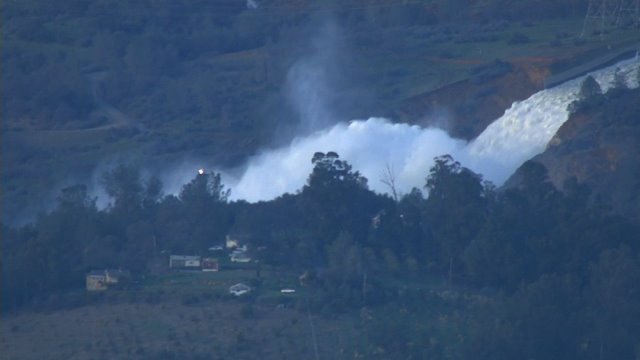A day after 188,000 people were evacuated from the towns surrounding Northern California’s Oroville Dam, officials sounded a note of cautious optimism about containing the threat of flooding.
Still, the mandatory evacuation order remained in place Monday for Butte, Sutter and Yuba counties.
The evacuation was initially ordered Sunday after a massive erosion hole was discovered in an emergency spillway — which catches excess water when Lake Oroville’s water level rises to overflow the dam — threatening communities downstream.
Some people had just a few minutes to prepare, in what one Oroville resident described as “pure chaos.”
Stores closed. Shelters opened. Police manned roadblocks. Evacuees waited in traffic trying to escape low-lying areas. Residents mobbed gas stations on their way out of town. By early Monday, many of the pumps at those gas stations had yellow tape across them, indicating they were out of gas.
Butte County Sheriff Kony Honea defended the decision to evacuate, saying the “dynamic” situation required a quick response.
“We did this because our primary purpose is to ensure public safety,” he said in a Monday news conference.
Situation improving at the dam
The Oroville Dam provides flood control for the region. The dam has two spillways to release water out of the lake to prevent overflow. Both have problems.
In the main spillway, which is lined, or paved, erosion has caused a hole almost the size of a football field and at least 40 feet deep to form in the lower part of the channel. It can’t be fixed immediately.
The emergency spillway, which is an embankment covered with trees, is a last resort and was used for the first time in history on Saturday when the lake topped 901 feet, its capacity, and a light flow of water washed into the spillway.
Crews worked Monday to restore water levels and to repair dam controls before rains expected later in the week.
Water is no longer flowing over the emergency spillway and lake levels are continuing to fall, Honea said. The goal is to lower lake levels by 50 feet in anticipation of the rain, which could come as soon as Wednesday.
These efforts come amid mounting questions about why more had not been done to prevent spillway erosion after concerns were raised more than 10 years ago. California Department of Water Resources Acting Director Bill Croyle said he was “not familiar with 2005 documentation or conversation” about spillway concerns and emphasized the efforts underway to understand the current dynamics of the dam.
“We’re going to continue to work on the challenges we have,” he said.
Chaotic escape
Officials warned Sunday that a 30-foot “wall of water” could be sent rushing downstream if the eroding spillway were to collapse, prompting California Gov. Jerry Brown to issue a state emergency order to help local authorities.
Honea’s office issued a dire warning — “This is NOT a drill” — in imploring residents to evacuate. At the time, officials said the spillway was in danger of failing any minute.
The Sacramento Fire Department echoed the urgency and warned residents that the spillway failure could have effects, including flash flooding, 75 miles downstream in Sacramento.
“Everyone was running around,” Oroville resident Maggie Cabral told CNN affiliate KFSN on Sunday. “All of the streets were immediately packed with cars, people in my neighborhood grabbing what they could and running out the door and leaving.”
Sean Dennis, who lives 30 miles south of Oroville, spoke to CNN from his car after spending 4½ hours in heavy traffic.
“It was pretty scary, just because of how fast everything was developing,” he said. “Me and my wife managed to throw as much stuff as we could into garbage bags, whatever we could find. We got both of our cars loaded down pretty well. We’re not taking any chances.”
Racing Wednesday’s rain
After issuing the evacuation orders, authorities noted significant decreases in the water coming over the emergency spillway. The urgency later subsided, with authorities reporting that the situation was not as desperate as previously thought.
Still, Honea said Monday he wasn’t taking any chances by prematurely lifting the evacuation order.
“It was a hard decision to make but I can tell you the decision to release the evacuation is an equally difficult decision.”
The main spillway was releasing water at 100,000 cubic feet per second Monday afternoon in an effort to reduce the amount of water traveling down the emergency spillway, Croyle said.
Normal flows down the main spillway are about 55,000 cubic feet per second. An Olympic swimming pool typically holds about 88,000 cubic feet of water.
Crews used helicopters to drop bags of rocks into the gouged portion of the emergency spillway, in an effort to plug the hole, Croyle said Monday.
“When or how long this takes depend on the dynamics of watershed,” he said.
Unprepared after years of drought
Oroville Dam is the country’s tallest, and the emergency spillway that’s eroding had never been used before in 48 years of existence, the DWR said. The closest it came to being used was in January 1997, when Lake Oroville’s water level rose to within a foot of flowing over it.
The area had long been in drought, until this year, when heavy rain and snow bombarded the state. In Oroville, the average annual rainfall is about 31 inches, but since October, the Feather River, which begins at Lake Oroville, had already seen 25 inches of rain as of Saturday, according to the California Department of Water Resources.
The lake also gets water from the northern Sierra Nevada mountain range, which is experiencing one of its wettest seasons.



